Oil And Gas Separator Market Research, 2032
The global oil and gas separator market was valued at $8.0 billion in 2022, and is projected to reach $11.7 billion by 2032, growing at a CAGR of 4.1% from 2023 to 2032.
Report Key Highlighters:
- The oil and gas separators sets market analysis study covers 20 countries. The research includes a segment analysis of each country in terms of value ($million) for the projected period 2023-2032.
- The study incorporated research methodology aims to present a comprehensive outlook on global markets and aid key stakeholders & players in making well-informed decisions to accomplish their ambitious growth goals.
- Over 1,500 product literatures, industry statements, annual reports, and other comparable materials from major oil and gas separator industry participants were reviewed to gain a better understanding of the market.
- The oil and gas separator market is fragmented, with several players including Honeywell International Inc., HAT International, Schlumberger Limited, FMC Technologies, ACS Manufacturing, Inc., Sulzer AG., Exterran Corporation, ALFA LAVAL, Twister BV, and CECO Environmental Corp. Also tracked key strategies such as acquisitions, product launches, developments, partnership, mergers, expansion etc. of the players operating in the oil and gas separator industry.
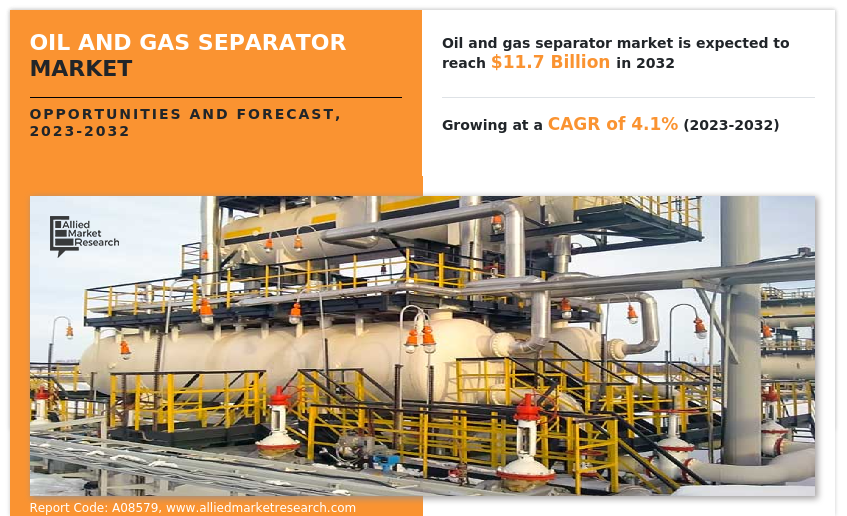
Oil and gas separators have emerged as indispensable components in the energy sector, offering efficient solutions in the extraction and processing of hydrocarbons. These systems efficiently segregate oil, gas, and water from the well stream, ensuring a streamlined production process in diverse applications and locations. Their flexibility and scalability make them a crucial technology in the oil and gas industry, adapting to various extraction scenarios, whether onshore or offshore.
One of the major advantages of oil and gas separators lies in their ability to ensure efficient extraction operations. These separators manage different types of crude oil, varying gas-to-oil ratios, and changing well conditions. Their adaptability to different environments, from conventional wells to more challenging and complex reservoirs, showcases their versatility in supporting the energy sector.
Moreover, oil and gas separators play a pivotal role in maintaining a consistent and uninterrupted supply of hydrocarbons. They ensure the efficient separation of oil, gas, and water, vital in optimizing production processes. The rapid response of these separators to fluctuating conditions within wells aids in the continuous and smooth flow of hydrocarbons, a crucial aspect of the energy industry's stability.
The growth of the oil and gas separator market is influenced by various factors. The increase in demand for efficient hydrocarbon extraction and processing in both developed and emerging economies has created a surge in the need for these systems. Especially in regions where oil and gas production are prevalent, separators are an essential component of the extraction process, ensuring optimized operations and productivity.
Furthermore, these systems offer a scalable and adaptable solution for the energy industry. Whether in small-scale extraction facilities or large industrial sites, oil and gas separators are configured to meet specific requirements, catering to a wide range of applications. Their adaptability is a key feature, addressing the needs of various sectors within the oil and gas industry.
However, challenges exist in the adoption of oil and gas separators, notably in environmental impact. Certain types of separators, especially those in older systems, may contribute to environmental concerns through emissions or inadequate disposal processes. Addressing these challenges requires focusing on sustainable and environmentally friendly technologies, enhancing the separators' eco-friendliness, and promoting cleaner extraction processes.
In addition, the maintenance and operation of oil and gas separators require technical expertise. Access to skilled personnel for reliable and efficient operation in regions with limited resources is a challenge. Building local capacity and investing in training programs are crucial for the effective and sustainable operation of these systems.
Despite these challenges, the oil and gas separator market hold significant growth potential. Their efficiency and adaptability play a crucial role in ensuring optimized hydrocarbon extraction, making them an essential solution for the energy industry. As industry evolves and demands cleaner and more sustainable extraction practices, the development and innovation of oil and gas separators will be pivotal in meeting these evolving needs.
The oil and gas separator market scope is segmented on the basis of technology, type, vessel type, application, and region. By technology, the market is divided into gravity separators, centrifugal separators, mist eliminators, filter vane separators, and liquid/gas coalescers. By type, the market is segregated into two-phase separators, three-phase separators, and degassers. On the basis of vessel type, it is segregated into horizontal, vertical, and others. On the basis of application, it is bifurcated into onshore, and offshore. Region-wise, the oil and gas separator market trends are analyzed across North America, Europe, Asia-Pacific, and LAMEA.
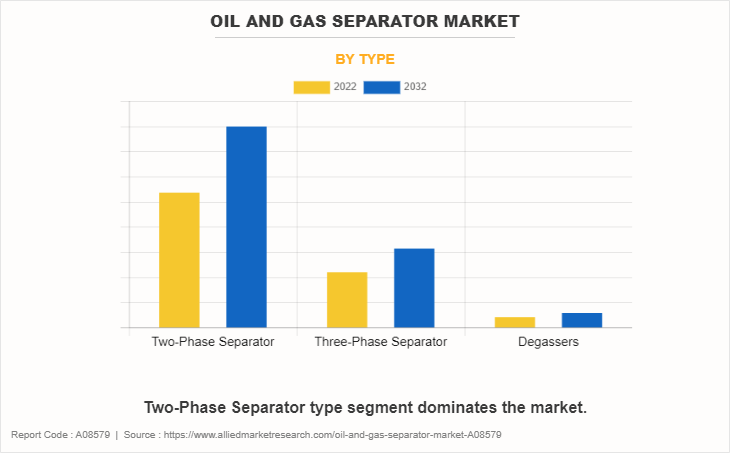
Based on type, the two-phase separator segment held the highest oil and gas separator market share in 2022, accounting for more than two-thirds of the global market revenue, and is estimated to maintain its leadership status throughout the forecast period. The market for two-phase separators in oil and gas is expected to continue its upward trajectory, driven by evolving technological advancements, rising energy demands, and the pursuit of more sustainable practices within the sector.
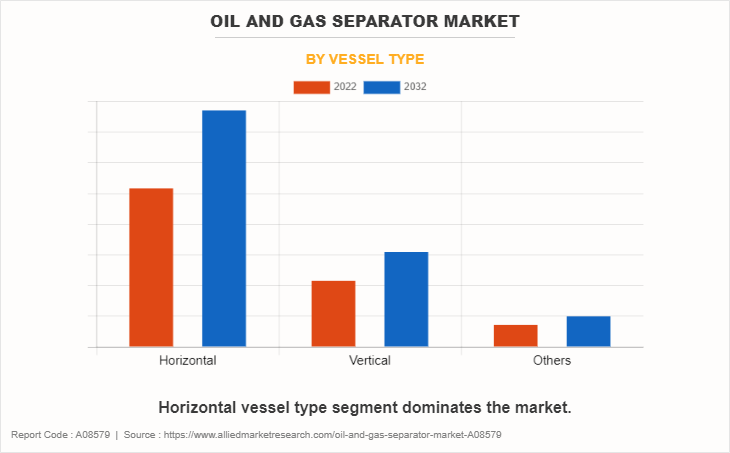
Based on vessel type, horizontal segment held the highest market revenue in 2022, accounting for nearly two-thirds of the global oil and gas separator market size, and is estimated to maintain its leadership status throughout the forecast period. The horizontal separator's compact design makes it suitable for offshore platforms and onshore facilities with limited space, contributing to its rising popularity. In addition, advancements in technology and materials are enhancing the performance and durability of horizontal separators, further fueling oil and gas separator market growth.
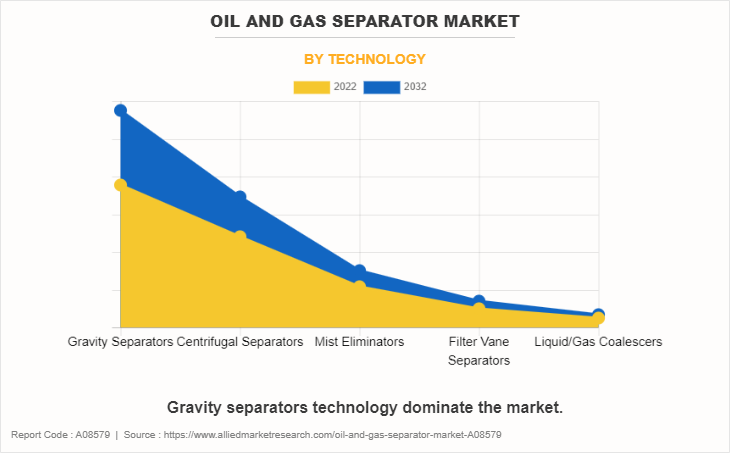
Based on the technology, the gravity separator segment held the highest market share in 2022, accounting for nearly half of the global oil and gas separator market revenue, and is estimated to maintain its leadership status throughout the forecast period. The increase in global energy demand has led to higher oil and gas production, boosting the demand for efficient separation technologies. In addition, stricter environmental regulations require improved separation methods to minimize emissions and reduce environmental impact. Technological advancements, such as enhanced designs and materials for separators, automation, and digital monitoring systems, are further driving the growth of gravity separator in oil and gas separator market.
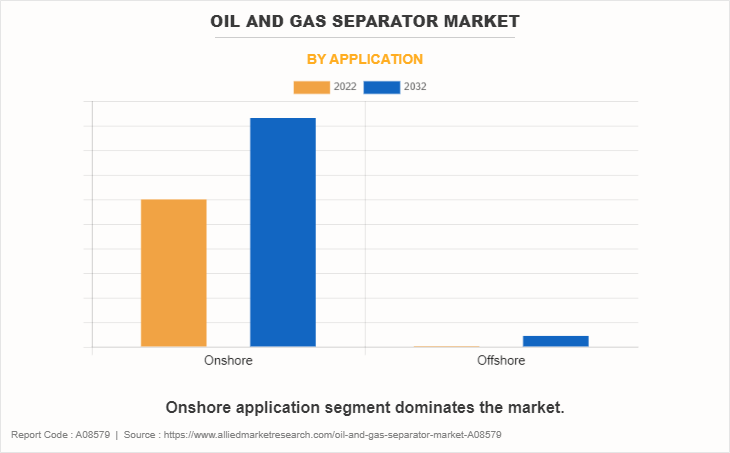
Based on the application, onshore held the highest market share in 2022, accounting for more than four-fifths of the global oil and gas separator market revenue, and are estimated to maintain their leadership status throughout the forecast period. Increase in global energy demand, coupled with the exploration and production of unconventional oil and gas resources, has led to the expansion of on-shore facilities. Technological advancements in separator design and efficiency enhancements contribute to the market's growth.
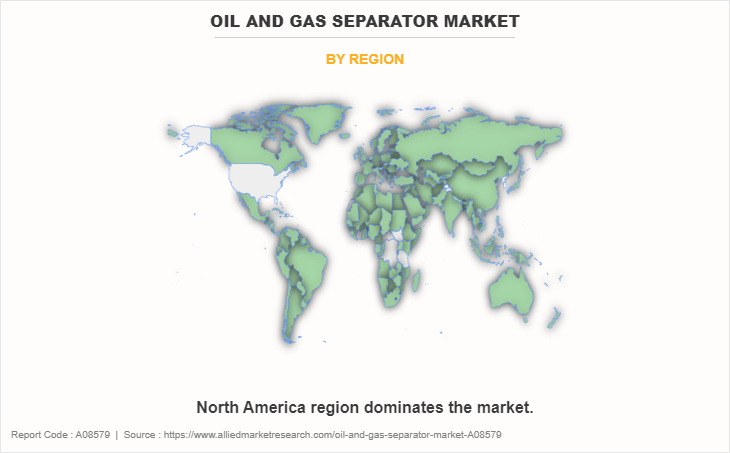
Based on region, North America held the highest market share in terms of revenue in 2022, accounting for more than one-third of the global oil and gas separator market revenue, and is likely to dominate the market during the forecast period. However, the Asia-Pacific region is expected to witness the fastest CAGR growth during the oil and gas separator market forecast.
Regional Development Of Oil And Gas Separators:
In North America, oil and gas separators are integral to the extraction process. In the U.S., these separators are widely utilized in both onshore and offshore applications. Stringent environmental regulations have led to the adoption of advanced separator technologies, ensuring more efficient and eco-friendly extraction methods.
Within Europe, oil and gas separators contribute to the efficient extraction of hydrocarbons, particularly in regions emphasizing sustainability and renewable energy. European countries are exploring cleaner and more eco-friendly options for these systems to align with environmental goals.
In the Asia Pacific, countries with varying levels of oil and gas extraction are embracing oil and gas separators to optimize their operations. In regions like India, these separators are vital for efficient extraction in diverse settings, including remote and challenging terrains.
Latin American countries are recognizing the importance of these separators in the extraction process. In nations such as Brazil, where environmental concerns and extraction efficiency are crucial, oil and gas separators are widely utilized, and there is a growing emphasis on eco-friendly extraction methods.
In Africa, oil and gas separators are instrumental in addressing energy extraction challenges. These systems are used across various sectors, particularly in regions with limited access to traditional grid infrastructure. Their role in ensuring efficient extraction is critical for the region's energy sector development and sustainability.
The development and utilization of oil and gas separators plays a crucial role in optimizing hydrocarbon extraction across different regions. Their adaptability and efficiency offer solutions to meet the diverse demands of the energy sector, facilitating sustainable and optimized extraction practices worldwide. As the industry progresses, innovations in oil and gas separator technology will be essential in meeting evolving extraction needs and environmental considerations.
Competitive analysis and profiles of the major oil and gas separator market players, such as Honeywell International Inc., HAT International, Schlumberger Limited, FMC Technologies, ACS Manufacturing, Inc., Sulzer AG., Exterran Corporation, ALFA LAVAL, Twister BV, and CECO Environmental Corp. are focusing their investment on technologically advanced, cost-effective, and more secure products and solutions for various applications.
Key Benefits For Stakeholders
- This report provides a quantitative analysis of the market segments, current trends, estimations, and dynamics of the oil and gas separator market analysis from 2022 to 2032 to identify the prevailing oil and gas separator market opportunities.
- The market research is offered along with information related to key drivers, restraints, and opportunities.
- Porter's five forces analysis highlights the potency of buyers and suppliers to enable stakeholders make profit-oriented business decisions and strengthen their supplier-buyer network.
- In-depth analysis of the oil and gas separator market segmentation assists to determine the prevailing market opportunities.
- Major countries in each region are mapped according to their revenue contribution to the global market.
- Market player positioning facilitates benchmarking and provides a clear understanding of the present position of the market players.
- The report includes the analysis of the regional as well as global oil and gas separator market trends, key players, market segments, application areas, and market growth strategies.
Oil and Gas Separator Market Report Highlights
| Aspects | Details |
| Market Size By 2032 | USD 11.7 billion |
| Growth Rate | CAGR of 4.1% |
| Forecast period | 2022 - 2032 |
| Report Pages | 280 |
| By Type |
|
| By Vessel Type |
|
| By Technology |
|
| By Application |
|
| By Region |
|
| Key Market Players | Sulzer AG., CECO Environmental Corp., HAT International, Exterran Corporation, ACS Manufacturing, Inc., Honeywell International Inc., ALFA LAVAL, Twister BV, Schlumberger Limited, FMC Technologies |
Analyst Review
As per insights gathered from industry leaders and Chief Executive Officers (CXOs), the oil and gas separators market is currently undergoing a transformative phase with a promising trajectory for substantial growth in the future. This evolution is predominantly attributed to the persistent demand for effective hydrocarbon separation solutions in various sectors, ranging from upstream exploration and production to downstream processing and environmental compliance within the oil and gas industry.
Oil and gas separators play a pivotal role in addressing the industry's need for efficient separation of oil, gas, and water phases, ensuring product quality, process optimization, and environmental compliance. These separators are valued for their versatility and adaptability, allowing them to cater to diverse applications across the sector, including offshore platforms, refineries, and petrochemical plants.
A primary driver for the rapid expansion of the oil and gas separators market is the escalating focus on environmental compliance and the need to minimize the environmental footprint of hydrocarbon production. Regulatory bodies worldwide have imposed stringent emissions and water quality standards, necessitating advanced separator technologies to efficiently manage these challenges. This factor has prompted oil and gas companies to invest in cutting-edge separator solutions, which not only enhance environmental performance but also contribute to long-term operational efficiency.
The oil and gas industry, encompassing upstream, midstream, and downstream segments, relies on separator technologies to manage the intricate process of separating hydrocarbon mixtures. These separators are pivotal in maintaining the quality of refined products and the safety of operations. As such, the demand for these separators remains robust, with the industry recognizing their indispensable role in achieving reliable and efficient separation processes.
While the market enjoys numerous advantages and growth prospects, it is not without its challenges. The initial capital investment required for the installation of advanced separator systems is a notable barrier for potential buyers. However, it is essential to consider the long-term cost savings and the environmental benefits these systems offer, as they often outweigh the initial expenditure. Moreover, the successful operation and maintenance of these separator systems necessitate adequate training and technical support, underlining the importance of comprehensive customer support services to maximize performance and lifespan.
The global oil and gas separators market presents an exciting landscape, with opportunities for market expansion across various regions, including North America, Europe, Asia-Pacific, and the Middle East. While the challenges are evident, the industry is poised to address them and continue its growth trajectory, guided by advancements in separator technology and a commitment to meeting environmental and operational demands.
Advanced Technology Integration, Environmental Sustainability, Modularity and Customization, Remote Monitoring and Control, and Increased Focus on Efficiency are the upcoming trends of Oil and Gas Separator Market in the world
North America is the largest regional market for Oil and Gas Separator.
Onshore is the leading application of Oil and Gas Separator Market.
$11.7 billion is the estimated industry size of Oil and Gas Separator market in 2032.
Alfa Laval, Frames Group, Schlumberger Limited, Halliburton, FMC Technologies, ACS Manufacturing, Inc., Sulzer Ltd, CECO Environmental, Exterran Corporation, and Pentair plc are the top companies to hold the market share in Oil and Gas Separator
Loading Table Of Content...
Loading Research Methodology...



